Cockfighting is a brutal, bloody sport in which people place bets on gamecocks – roosters specially bred and trained for the purpose – which are then placed in a fighting pit and encouraged to fight.
It has been practiced all over the world for hundreds of years, and while many countries have denounced the bloodsport for its cruelty, it continues to be pervasive in many cultures.
Rooster Fighting
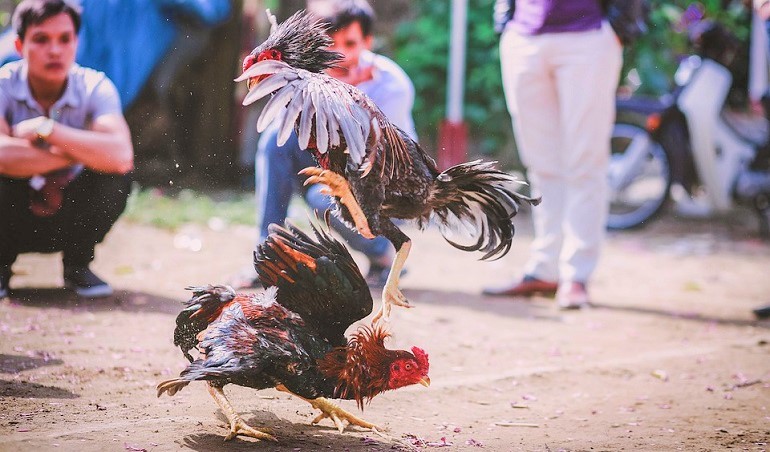
Gamecocks naturally have long, sharp spurs that grow off the back of their heels which are capable of inflicting an impressive amount of damage.
When two roosters fight using these, it is referred to as a “naked heel” match, but in some cases, spurs of metal or bone are slipped over these natural spurs for the fight, either to protect them or merely to inflict greater injury to the opponent.
The modern short spur is 4 cm or less in length, and the longer spurs can be up to 6 cm long.
Cocks are “put to the main” in a cockpit when they are between one and two years of age. Until then, they are often fed a specific diet and given the training to increase their ferociousness.
In a fight, a winner is declared when one gamecock kills the other, although there are some practices of the sport that allow the withdrawal at any time of a “badly damaged cock,” according to the Encyclopedia Britannica. Some practices set time limits for matches, and in that case, a winner is declared based on stats much like boxing.
Historical Perspective
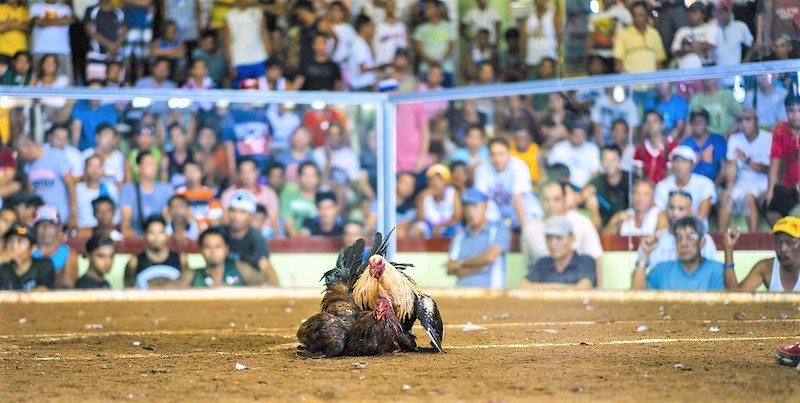
Cockfighting could very well be one of the world’s most ancient and prevailing sports. Its origins can be traced back to the Indus Valley civilization in south Asia – as in, the Bronze age – and there is evidence that the great Athenian general Themistocles was responsible for bringing the pastime home to Ancient Greece around 500 BC.
The Romans, always true to their bloodthirsty natures, embraced cockfighting with enthusiasm. They elevated the greek diversion to new levels by introducing artificial spurs for combat and developing a more organized system, which spread throughout their empire.
By the sixteenth century, cockfighting and other pit sports such as bear baiting, bullfighting, and dog fighting were international pastimes of great renown. In England, cockfighting was so commonly practiced by schoolboys that “cocking” was an annual event in some grammar schools.
Thus, when Europeans started colonizing the New World cockfighting and horse racing were the two most popular sports. By the early 19th century, cockfighting was prevalent in cities and rural areas all along the American east coast.
Because cockfighting is inextricably linked to gambling and other crimes, it has been a difficult sport to eradicate. When there are vast amounts of money to be made, people will find ways to do it, whether it’s legal or not.
Although many states had statutes against cockfighting by the early twentieth century, game cock breeding programs and contests continue to occur.
Regional Variations
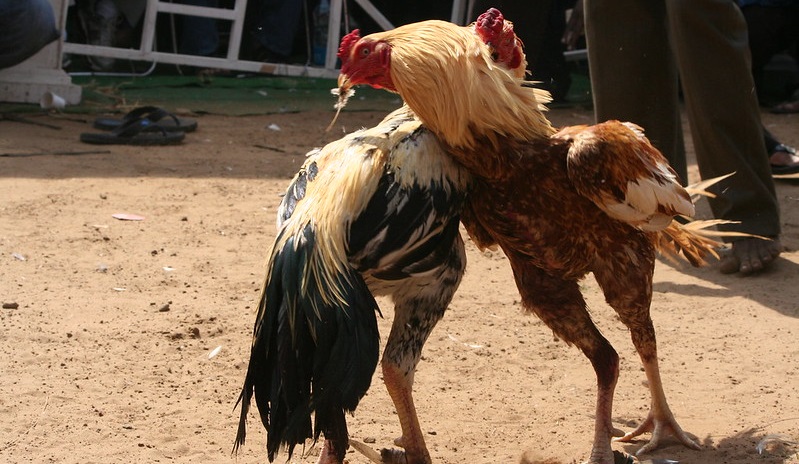
As would any sport that has evolved over hundreds of years in different locations, cockfighting has some distinctive regional variations.
For example, in Indonesia cockfights are performed as a ritual in Balinese Hinduism. Called tabuh rah, which translates to “pouring blood,” the ritual is done to provide an offering (the blood of the losing cock) to appease the evil spirits.
However, not all fights in the region are done for religious purposes – many people do it for sport as well.
In India, cockfighting famously occurs as entertainment during harvest festivals. The Prevention of Cruelty to Animals Act, passed in 1960, made cockfighting illegal for many years.
However, in 2018 the Supreme Court passed a judgment reversing several previous rulings, allowing cockfights for ritualistic purposes “in the traditional way,” (meaning without the use of knives and blades, and without gambling or betting.)
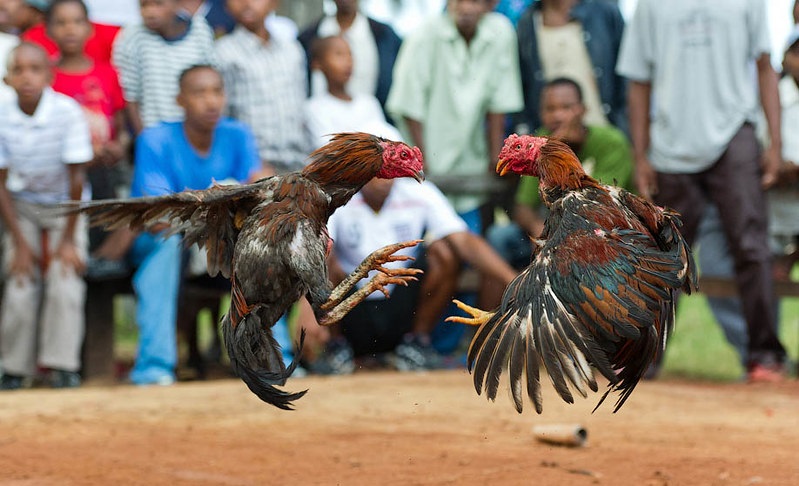
Now, cockfighting is pretty common throughout the southern Indian states, regardless of the purpose.
The Philippines have become famous for its legal cockfighting, with sanctioned fights occurring weekly in large, brightly-lit arenas. World Slasher Cup, or the “Olympics of Cockfighting,” is held here, as well as gamefowl expos that attract enthusiasts from around the world.
Illegal matches, called tupada or tigbakay, are also very popular but held in more clandestine locations where law enforcement is less likely to intervene.
Cockfighting is also very popular in Central and South America and is largely tolerated legally in many countries. For example, “bullfighting shows and cockfights are part of the National Folklore and as such allowed” in Honduras, despite the Animal Protection and Welfare Act passed there in 2016.
Such “allowances” for cockfighting have been made in Panama, some states in Mexico, and Peru as well.
Facts About Cockfighting
You probably think the cruelty in cockfighting is pretty obvious; it’s never good when two animals are forced to fight as a spectator sport. However, the animal suffering begins long before the birds are “put to the main.”
Read on to learn more facts about this gruesome practice.
Animal Cruelty
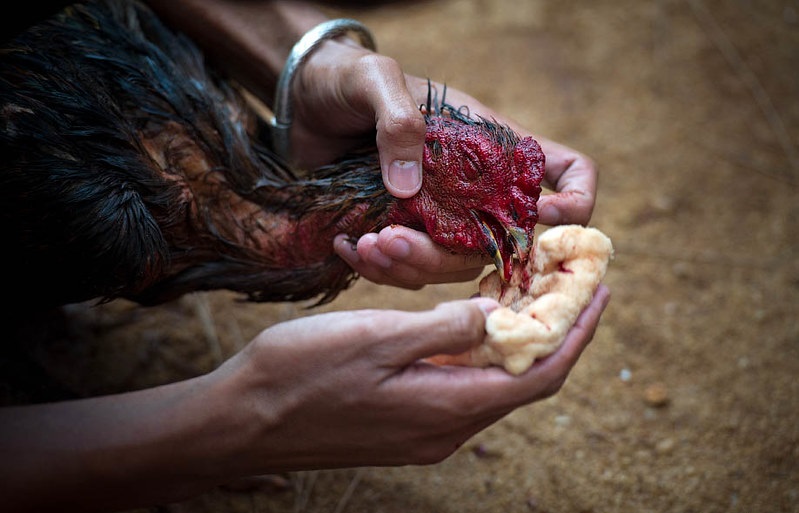
Depending on where the animal is raised, some gamecocks are treated horribly from the very start. According to the Humane Society, most roosters raised on a gamecock farm live tied to a stake, barrel, or small wooden hut.
They are often injected with steroids and other drugs that will help them develop stronger muscles and aggressive nature. Sometimes gamecocks are kept in a small dark box for weeks leading up to the fight – like they’re serving out a solitary sentence – to further frustrate and disorient them.
And, if steroids or other powerful drugs aren’t available, one traditional method of revving gamecocks up for a fight includes shoving cayenne up the rooster’s bum.
Then, there are the fights themselves. The pits are specially constructed so that the birds cannot escape them. Common injuries to the roosters include punctured lungs, broken bones, and pierced eyes, not to mention the deep gashes inflicted by their spurs.
If a rooster has suffered a punctured lung and is drowning in its own blood, it is common practice for the owner to suck the blood out through its beak so that the poor thing can continue fighting.
It gets even worse. According to a report done by the Humane Society, when a fight ceases to be entertaining enough for the main (due to injury or waning energy), the match gets relocated to a “drag pit” where it can continue for hours.
Remember: there is usually a great deal of money involved, so owners are very motivated to have their roosters fight as long as possible. Matches generally end when one of the birds is killed.
Sometimes, even the “winner” is subjected to further matches; “Blinker derbies” are when survivors who’ve lost their eyes are pitted against each other, and sometimes there is a practice known as “battle royale,” which is when all the wounded roosters are forced to fight until only one bird remains alive.
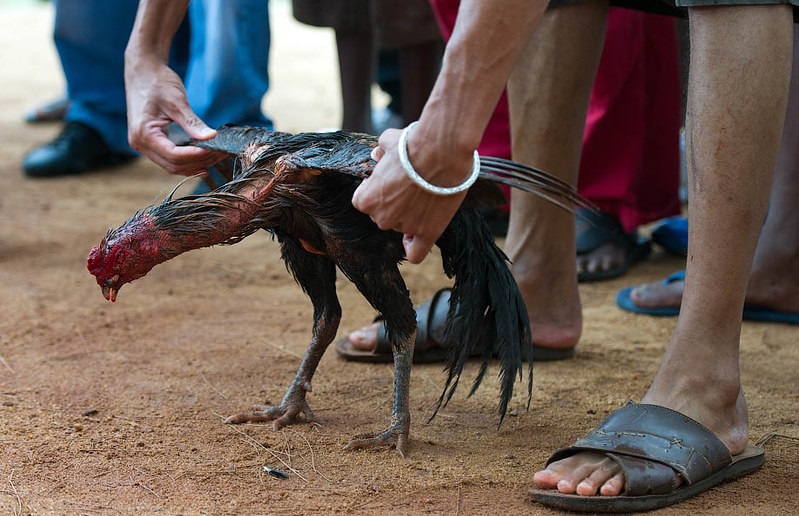
Breeding Criminal Activity
Since cockfighting’s lure is largely due to illegal gambling, the sport has a tendency to attract other nefarious crimes. Even when the matches are legal, there is almost always illegal betting as well, which breeds various forms of violence.
Especially in places like the Phillippines – where cockfights are done on a grand scale – it’s not uncommon for authorities to report rashes of home invasions, assaults, and even murders associated with the sport.
Cockfighting is also associated with drug trafficking, gang activity, and illegal weapon sales. In the past year, several cockfighting rings were discovered by authorities in the southwestern United States (Nevada, Arizona, and Washington).
In each separate case, they found large amounts of drugs (particularly Meth, which is sometimes given to the gamecocks), illegal weapons, and clear intent to distribute both.
General Justifications for Cockfighting
As gory as it may sound, people still come up with justifications to justify this bloody practice!
Gamecocks Are Natural Fighters
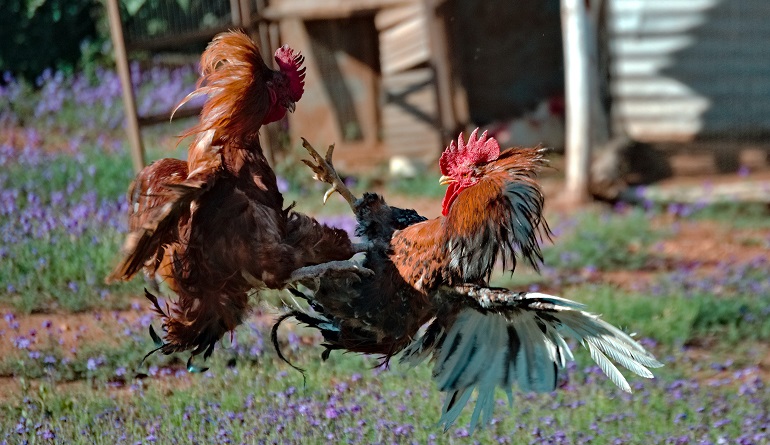
Cockfighters often excuse the violent nature of their sport by claiming that gamecocks come by their aggressive natures naturally. After centuries of selective breeding to encourage this trait, there is a kernel of truth to that statement.
Birds will naturally fight over food, territory, or mates, and to establish a “pecking order.” However. The type of fighting that occurs for these purposes rarely results in serious injury or one of the birds being killed.
That is clearly not the case when they are forced to fight in the cockpits. On those occasions, the birds are abused, injected with substances, and encouraged to fight long past dominance having been established.
It’s Part of Culture
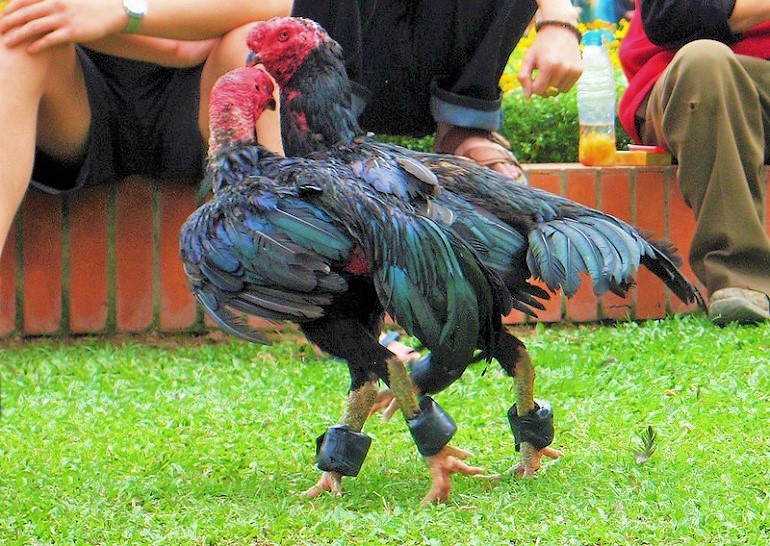
The cultural aspect of cockfighting is tougher to debate, depending on the background of the person. As we’ve mentioned, cockfighting has been performed for hundreds of years, and particularly in Indonesia and other eastern countries it is associated with religious rituals.
We are not here to debate the merits of one religion or another, but it does make one wonder: could even the religious aspect perhaps be made more humane without losing its original intent?
Something that is done for the sake of tradition doesn’t automatically grant it moral righteousness.
Using the cultural argument in defense of cockfighting is weak, at best. The sport as it was practiced historically was very different, and there are plenty of traditions that we have seen fit to recognize as inhumane or unnecessary as times have changed.
With the exception of the authentic religious rituals that are performed (which are in the minority), cockfighting is merely a violent form of entertainment and practice that encourages criminal activity.
Why Is It Illegal?
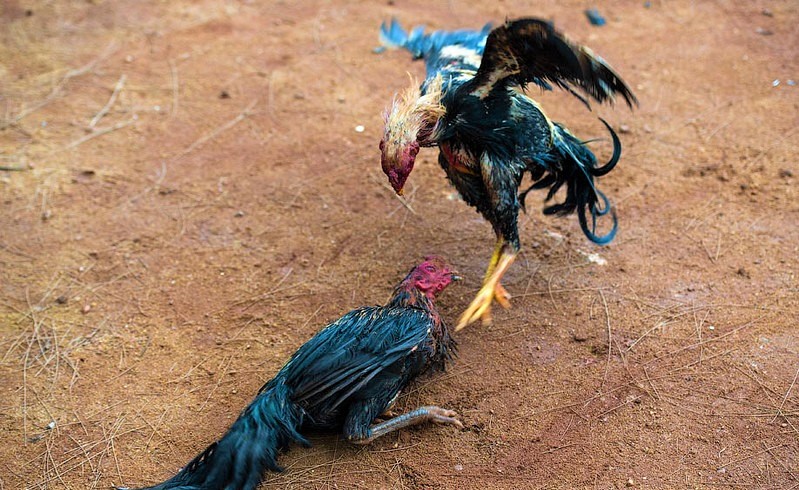
Cockfighting is illegal in many countries for a few common reasons: either an anti-animal cruelty law is in place, or it has been banned because of its close association with other illegal activities like gambling, illegal weapons, gang violence, and drug trafficking.
It’s also been banned because it’s incredibly dangerous for the people handling the game fowl and other roosters. In addition to spreading disease to their handlers and spectators (more on that in a moment), gamecocks have been known to inflict serious injuries — even death — with their sharp spurs.
In the United States, cockfighting is a crime in every state, and 42 states penalize it as a felony. It is illegal to be a spectator at fights in 43 states, possess or sell birds for fighting in 39 states, and possess animal fighting paraphernalia in 29 states.
Only five states specifically prohibit adults from taking children to a fight, but the HSUS is working on that.
How Is Disease Spread Linked with Cockfighting?
Cockfighting contributes to the spread of disease in a number of ways. Those who raise and sell roosters for fighting often do so in large numbers, keeping hundreds or even thousands of birds within a small area.
The conditions in which the roosters are raised are rarely sanitary, and the close quarters make for an ideal environment for the unchecked and rapid spread of contagions.
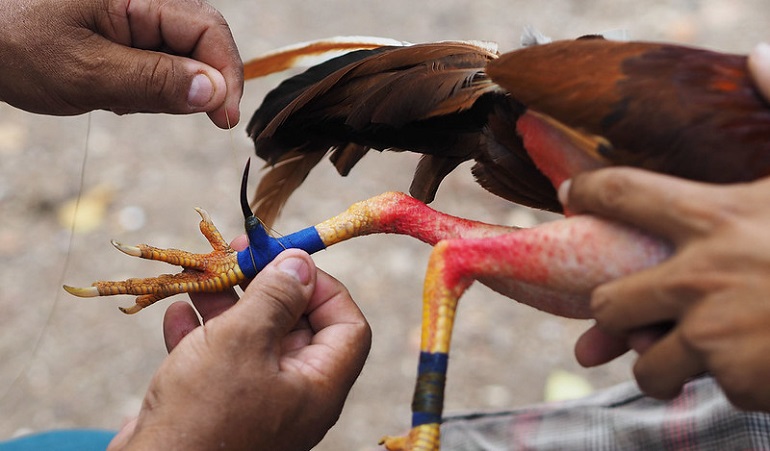
Then, because selling and transporting gamecocks is regularly done without regulation or oversight (partially due to laws against doing so), the disease is easily spread over even greater distances.
Many cockfighters travel with their birds to countries where the sport is legal, thereby contributing to the spread of disease amongst humans, as well.
According to the WHO (World Health Organization), infected fighting cocks may have caused at least eight confirmed human cases of avian influenza in Thailand and Vietnam since 2004. It is assumed they contracted the virus by handling their birds during a fight, thereby coming into contact with blood, feces, and bodily fluids.
This article discusses the implications of Thai cockfighting and Avian flu. The more times a human contracts the virus, the greater the chance the disease will mutate and become more contagious in our species.
Avian influenza presents a serious threat to our health. In 2020 the WHO reported 861 verified cases of avian influenza in humans and 455 deaths. (Avian flu has a 60% mortality rate, which is staggering. COVID-19’s mortality rate is 3.3%, to give you an idea.)
The CDC considers the risk to the general public to be low but released this statement: “Human infections with avian influenza viruses have occurred after close and prolonged contact with infected birds or the excretions/secretions of infected birds.
Risk is dependent on exposure. People with close or prolonged unprotected contact with infected birds or contaminated environments are likely to be at greater risk of infection.”
Spreading disease isn’t only a problem when humans get sick. In 2020 the United States had an outbreak of Virulent New Castle Disease, which is a contagious, untreatable, and deadly viral respiratory infection of birds.
Transmission occurs when healthy birds come in direct contact with the bodily fluids of sick birds, and it can travel on the surface of equipment and clothing as well. Over 1.2 million backyard or commercial birds died or were euthanized as a result of this epidemic. And you guessed it: VND is closely associated with cockfighting.
How the HSUS Combats Cockfighting
In America, institutionalized opposition to cockfighting began in 1866 when Henry Bergh, a wealthy New Yorker, began the American Society for the Prevention of Cruelty to Animals. His chapter eventually grew into what we know as the Humane Society or the HSUS.
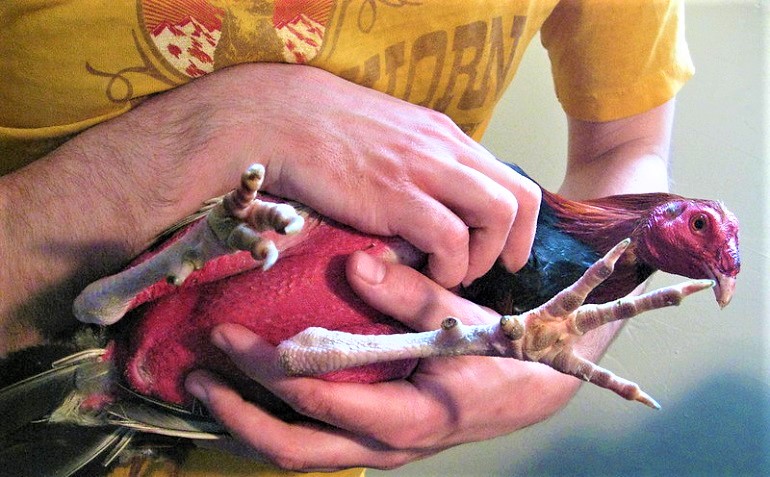
Public Policy
Although the HSUS has worked tirelessly over the subsequent decades to shape public policy regarding cockfighting, in the past 20 years or so their fight has mostly involved lobbying to close the loopholes that exist in current legislation.
Their hardest task has been working with Congress and their allies to upgrade the federal law about Animal Fighting Prohibition
Act. In the five amendments to the law that they have succeeded in helping to pass, they have made it a federal crime to attend a cockfight, to bring a child to one, or to transport birds across state lines for fighting.
They have also actively fought opposition to pass a bill clarifying that this law applies to all U.S. territories, so in 2019 all animal fighting became prohibited in Guam, Puerto Rico, and the U.S. Virgin Islands.
Law Enforcement Support
In addition to working with lawmakers, the HSUS has assisted authorities in enforcing these laws. They are partnered with the National Sheriffs Association to train officers nationwide on how to investigate animal fighting crimes.
They have also hosted trainings with the FBI and the Department of Justice, so federal agents and prosecutors can act confidently in their pursuits as well.
The HSUS also has a specialized branch called the Animal Rescue Team, with animal fighting experts available to assist local law enforcement agencies in carrying out investigations and raids.
They also have professional investigators who act as confidential informants who can provide intelligence to law enforcement and testify in court in order to aid in the prosecution of animal fighters.
How Can you Help?
The best way to help in the campaign against animal cruelty is to speak out and educate others.
By spreading information – on social media, in classrooms, or even through letter-writing campaigns – you can raise awareness about the cruelty of animal fighting, and help people recognize when it might be happening around them.
If you suspect that cock fighting is happening around you (things to look for: large populations of roosters kept in one location, roosters with their waddles or combs removed, signage suddenly advertising a “poultry show” that is a little too popular) please report to your local law enforcement agency.
Conclusion
One can only hope that as more people gain an understanding of how truly awful this blood sport is, more will speak out against it, enact new laws, and provide funding to support the enforcement of existing ones.


